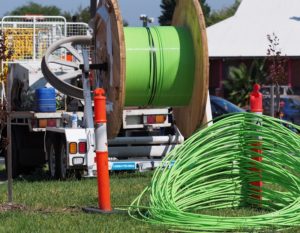
Learn how common fiber optic deployments differ from each other.
While most fiber optic cables are installed to support long-distance connections between cities and countries, some deployments cover distances from the telecom facility, or central office, to the end-user. Generally, this deployment is referred to as FTTx or “Fiber to the X,” with the X representing the various types of end deployment architecture available. The kinds of Fiber to the X include FTTN, FTTB, FTTH, and FTTD. Read on to learn what each of these fiber optic deployments refers to and how their structures differ.
FTTN
In a Fiber to the Node/Fiber to the Neighborhood deployment, the optical fiber ceases at the node, which lies a few miles from the customer. Then, copper wires complete the connection to the customers. This fiber optic node deployment replaces the previous “plain old telephone service.” If you imagine the telephone lines hanging in your neighborhood replaced by optical fiber lines, you can imagine how wide-reaching these fiber optic deployments can be.
FTTB
This stands for Fiber to the Building and refers to fiber that is laid from the Service Provider’s central office to the building. It can also be known as “FTTP” or Fiber to the Premises. With FTTB, new products and services can be activated remotely. FTTB’s performance can also be monitored and can be repaired before a customer even realizes the problem. FTTB is relatively easy to maintain and less susceptible to harsh weather. This deployment completely eliminates the need for bulky, expensive high pair count copper cable.
FTTH
Fiber to the Home occurs when optic cabling ends directly at the individual home or business. There are different types of FTTH network structures based on the transport protocol and how data is encoded and transmitted. Fiber may be run directly from the central office to the building’s demarcation point (DEMARC). Alternatively, it may be run to centralized splitters that further distribute individual fiber strands to Passive Optical Network devices.
FTTD
Fiber to the Desk is one of the more common fiber optic deployments in commercial environments. Here, fiber is distributed from a Telecommunication Room out to the Equipment Outlets and terminated at a faceplate just as with copper cable. Unlike the other deployments that use Single Mode fiber, FTTD will typically be two or more strands of Multimode OM3 or OM4 fiber to the Equipment Outlet. This provides secure connections to desktop devices that have high bandwidth requirements.
Get in Touch with FiberPlus
FiberPlus has been providing data communication solutions for 28 years in the Mid Atlantic Region for a number of different markets. What began as a cable installation company for Local Area Networks has grown into a leading provider of innovative technology solutions improving the way our customers communicate and keeping them secure. Our solutions now include:
- Structured Cabling (Fiber Optic, Copper and Coax for inside and outside plant networks)
- Electronic Security Systems (Access Control & CCTV Solutions)
- Wireless Access Point installations
- Public Safety DAS – Emergency Call Stations
- Audio/Video Services (Intercoms and Display Monitors)
- Support Services
- Specialty Systems
- Design/Build Services
FiberPlus promises the communities in which we serve that we will continue to expand and evolve as new technology is introduced within the telecommunications industry.
Have any questions? Interested in one of our services? Call FiberPlus today 800-394-3301, email us at info@fiberplusinc.com, or visit our contact page. Our offices are located in the Washington, DC metro area and Richmond, VA. In Pennsylvania, please call Pennsylvania Networks, Inc. at 814-259-3999.
Do you enjoy clicking “Like” and “Follow?” Be sure to click on our official Pinterest, Facebook, Twitter, and LinkedIn pages today!